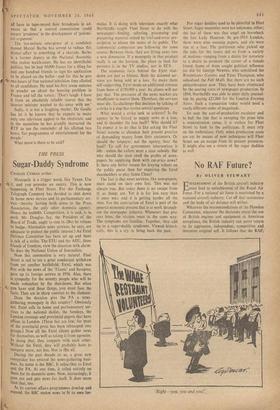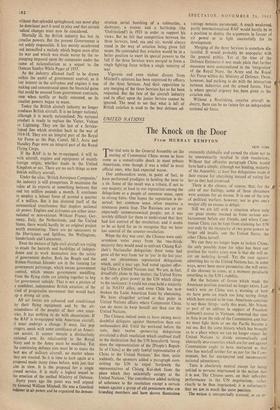No RAF Future?
By OLIVER STEWART
ENFEEBLEMENT of the British aircraft industry must lead to enfeeblement of the Royal Air Force. For a national air force is nourished by a national aircraft industry. Cut off that sustenance and the body of air defence will wither.
Whatever the recommendations of the Plowden Committee, whatever the decisions about the use of British engines and equipment in American aeroplanes, the British industry can never return to its aggressive, independent, competitive and inventive original self. It follows that the RAF, Atithout that splendid springboard, can never play he dominant part it used to play and that certain radical changes must now be considered.
Mortally ill, the British industry has lost its creative powers. But the present Government is not solely responsible. It has merely accelerated rnd intensified a malady which began soon after he war and which was made worse by the re- grouping imposed upon the companies under the name of rationalisation as a sequel to the Duncan Sandys White Paper of 1957.
As the industry allowed itself to be drawn within the ambit of government control; as it lost interest in the airframes and engines it was making and concentrated upon the financial gains that could be secured from government contracts, even when tardily or badly executed, so its creative powers began to wane.
Today the British aircraft industry no longer produces British aircraft. It is no longer national, although it is nearly nationalised. No national product is ready to replace the Victor, Vulcan or Lightning. They are the last of a Service- linked line which stretches back to the war of 1914-18. They are an integral part of the Royal Air Force as the Pup, Camel, SE 5, Avro and Handley Page were an integral part of the Royal Flying Corps.
If the RAF is to be re-equipped, it will be with aircraft, engines and equipment of mainly foreign origin, whether made in the United Kingdom or not. There are no such things as new British military aircraft.
Under the alias, 'British Aerospace Companies,' the industry is still prosperous. It maintains the value of its exports at something between five and ten million pounds a month. It continues to employ a labour force of around a quarter of a million. But it has divested itself of the aeronautical creativeness that inspires national air power. Engines and airframes are either inter- national or non-existent. Without France, Ger-. many, Italy, the Netherlands, and the 'United States, there would hardly be an original project worth mentioning. There are no successors to the Hurricanes and Spitfires, the Wellingtons, Sunderlands and Lancasters.
Even the makers of light civil aircraft are trying to evade the hazards and hardships of indepen- dence and to work themselves into the safety of government shelter. Both the Beagle and the Britten-Norman Islander are in the running for government patronage, which means government control, which means government meddling. Even the flying clubs are joining together to beg for government subsifily. That is not a picture of a confident, independent British aviation; of the kind of progressive movement that would back up a strong air arm.
All air forces are coloured and conditioned by their flying equipment and by the air- mindedness of the peoples of their own coun- tries. It has nothing to do with chauvinism. If the RAF is re-equipped with American aircraft, it must undergo a change. It must, like pop singers, speak with some semblance of an Ameri- can accent. It cannot remain a distinctively national arm. Its relationship to the Royal Navy and to the Army must be modified. Yet the continuing defence aim must be to make the best use of military aircraft, no matter where they are created. So it is time to look again at a proposal made many times before, with just that aim in view. It is the proposal for a single armed service. It is really a logical sequel to the creation of the unified Ministry of Defence.
Forty years ago the point was well argued by General William Mitchell. He was a fanatical believer in air power and he organised the demon-
stration aerial bombing of a submarine, a destroyer, a cruiser and a battleship (the 'Ostfriesland') in 1921 in order to support his views. But he felt that competition between the three Services, land, sea and air, would always stand in the way of aviation being given full scope. He contended that aviation would be in a better position to exert its special powers to the full if the three Services were merged to form a single fighting force within a single ministry of war
Vigorods and even violent dissent from Mitchell's opinions has been expressed by officers of the three Services. And their opposition to any merging of the three Services has so fax been respected. But the fate of the aircraft industry and its effect upon the junior Service cannot be ignored. The need to see that what is left of British aviation is used to the best defence ad-
vantage remains paramount. A much weakened, partly internationalised RAF would hardly be in a position to deploy the arguments in favour of air power or to light successfully for its development.
Merging of the three Services is somehow dis- tasteful. It would probably be unpopular with the general public. Yet at the time of the Defence Estimates it was made plain that further measures were contemplated in the 'integration' of the Royal Navy, the Army and the Royal Air Force within the Ministry of Defence. These, however, had nothing to do with the interaction between industries and the armed forces. That is where special urgency has been given to the aviation side.
Without a flourishing, creative aircraft in- dustry, there can be no future for an independent national air force.



















































 Previous page
Previous page